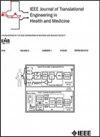Unstructured Electronic Health Records of Dysphagic Patients Analyzed by Large Language Models
IF 4.4
3区 医学
Q2 ENGINEERING, BIOMEDICAL
IEEE Journal of Translational Engineering in Health and Medicine-Jtehm
Pub Date : 2025-03-19
DOI:10.1109/JTEHM.2025.3571255
引用次数: 0
Abstract
Objective: Dysphagia is a common and complex disorder that complicates both diagnoses and treatment. Consequently, the associated electronic health records (EHR) are often unstructured and complex, posing challenges for systematic data analysis.Methods and procedures: In this study, we employ natural language processing (NLP) techniques and large language models (LLMs) to automatically analyze clinical narratives and extract diagnostic information from a diverse set of EHRs. Our dataset includes medical records from 486 patients, representing a group with diverse dysphagic conditions. We analyze diagnoses provided in unstructured free text that do not follow a standardized structure. We utilize clustering algorithms on the extracted diagnostic features to identify distinct groups of patients who share similar pathophysiological swallowing dysfunctions.Results: We found that basic NLP techniques often provide limited insights due to the high variability of the data. In contrast, LLMs help to bridge the gap in understanding the nuanced medical information about dysphagia and related conditions. Although applying these advanced LLM models is not straightforward, our results demonstrate that leveraging closed-source models can effectively cluster different categories of dysphagia.Conclusion: Our study provides therefore evidence that LLMs are highly promising in future dysphagia research.Clinical impact: Dysphagia is a symptom associated with various diseases, though its underlying relationships remain unclear. This study demonstrates how analyzing large volumes of electronic health records can help clarify the causes of dysphagia and identify contributing factors. By applying natural language processing, we aim to enhance both understanding and treatment, supporting clinical staff in improving individualized care by identifying relevant patient cohorts. Clinical and Translational Impact Statement: This study uses LLMs to efficiently preprocess unstructured EHRs, improving dysphagia diagnosis and patient clustering. It aligns with Clinical Research, enhancing diagnostic speed and enabling personalized treatment.用大语言模型分析吞咽困难患者的非结构化电子健康记录
目的:吞咽困难是一种常见而复杂的疾病,其诊断和治疗都很复杂。因此,相关的电子健康记录(EHR)往往是非结构化和复杂的,给系统数据分析带来了挑战。方法和步骤:在本研究中,我们采用自然语言处理(NLP)技术和大型语言模型(LLMs)来自动分析临床叙述并从各种电子病历中提取诊断信息。我们的数据集包括来自486名患者的医疗记录,代表了患有不同吞咽障碍的人群。我们分析在没有遵循标准化结构的非结构化自由文本中提供的诊断。我们在提取的诊断特征上使用聚类算法来识别具有相似病理生理吞咽功能障碍的不同患者组。结果:我们发现,由于数据的高度可变性,基本的NLP技术通常提供有限的见解。相比之下,法学硕士有助于弥合理解有关吞咽困难和相关疾病的细微医学信息的差距。虽然应用这些先进的LLM模型并不简单,但我们的研究结果表明,利用闭源模型可以有效地聚类不同类别的吞咽困难。结论:我们的研究为llm在未来的吞咽困难研究中提供了非常有前景的证据。临床影响:吞咽困难是一种与多种疾病相关的症状,尽管其潜在的关系尚不清楚。这项研究表明,分析大量的电子健康记录可以帮助澄清吞咽困难的原因,并确定导致吞咽困难的因素。通过应用自然语言处理,我们的目标是提高理解和治疗,支持临床工作人员通过识别相关的患者队列来改善个性化护理。临床和转化影响声明:本研究使用LLMs有效预处理非结构化电子病历,改善吞咽困难的诊断和患者聚类。它与临床研究相一致,提高了诊断速度并实现了个性化治疗。
本文章由计算机程序翻译,如有差异,请以英文原文为准。
求助全文
约1分钟内获得全文
求助全文
来源期刊

IEEE Journal of Translational Engineering in Health and Medicine-Jtehm
Engineering-Biomedical Engineering
CiteScore
7.40
自引率
2.90%
发文量
65
审稿时长
27 weeks
期刊介绍:
The IEEE Journal of Translational Engineering in Health and Medicine is an open access product that bridges the engineering and clinical worlds, focusing on detailed descriptions of advanced technical solutions to a clinical need along with clinical results and healthcare relevance. The journal provides a platform for state-of-the-art technology directions in the interdisciplinary field of biomedical engineering, embracing engineering, life sciences and medicine. A unique aspect of the journal is its ability to foster a collaboration between physicians and engineers for presenting broad and compelling real world technological and engineering solutions that can be implemented in the interest of improving quality of patient care and treatment outcomes, thereby reducing costs and improving efficiency. The journal provides an active forum for clinical research and relevant state-of the-art technology for members of all the IEEE societies that have an interest in biomedical engineering as well as reaching out directly to physicians and the medical community through the American Medical Association (AMA) and other clinical societies. The scope of the journal includes, but is not limited, to topics on: Medical devices, healthcare delivery systems, global healthcare initiatives, and ICT based services; Technological relevance to healthcare cost reduction; Technology affecting healthcare management, decision-making, and policy; Advanced technical work that is applied to solving specific clinical needs.
 求助内容:
求助内容: 应助结果提醒方式:
应助结果提醒方式:


